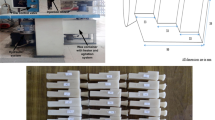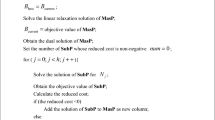Abstract
A critical process in brass casting is blending of the raw materials in a furnace so that the specified metal ratios are satisfied. The uncertainties in raw material compositions may cause violations of the specification limits and extra cost. In this study, we proposed a chance-constrained stochastic programming approach for blending problem in brass casting industry to handle the statistical variations in raw material compositions. The proposed approach is a non-linear mathematical model that is solved global optimally by using GAMS/BARON solver. An application has been performed in MKEK brass factory in Kırıkkale, Turkey and the solution of the application has been compared with alternative solution approaches based on cost and specification violation risk conditions. This comparison demonstrates that the proposed model is the most effective solution approach for managing stochastic uncertainties in blending problems and successfully can be used other industries such as alloy steel or secondary aluminum production.
Similar content being viewed by others
References
Agnew, N. H., Agnew, R. A., Rasmussen, J., & Smith, K. R. (1969). An application of change constrained programming to portfolio selection in a casualty insurance firm. Management Science, 15(10), B512–B520.
Agpak, K., & Gokcen, H. (2007). A chance-constrained approach to stochastic line balancing problem. European Journal of Operational Research, 180, 1098–1115.
Al-Shammari, M., & Dawood, I. (1997). Linear programming applied to a production blending problem: a spreadsheet modeling approach. Production and Inventory Management, 38, 1–7.
Ashayeri, J., van Eijs, A. G. M., & Nederstigt, P. (1994). Blending modelling in a process manufacturing: a case study. European Journal of Operational Research, 72, 460–468.
Blanchard-Gaillard, D., Yano, C. A., Leung, J. M. Y., & Brown, M. J. (1999). Discrete deterministic and stochastic blending problems with two quality characteristics: aluminum blending. IIE Transactions, 31, 1001–1009.
Bliss, N. G. (1997). Advances in scrap charge optimization. American Foundrymen’s Society Transactions, 105, 27–30.
Buehlmann, U., Ragsdale, C. T., & Gfeller B. (2000). A spreadsheet-based decision support system for wood panel manufacturing. Decision Support Systems, 29, 207–227.
Candler, W. (1991). Coal blending with acceptance sampling. Computers and Operations Research, 18, 591–596.
Charnes, A., & Cooper, W. W. (1959). Chance-constrained programming. Management Science, 6, 73–79.
GAMS Developments Cor. (2005). GAMS A Users Guide. Washington, USA.
Hasuike, T., & Ishii, H. (2009). Product mix problems considering several probabilistic conditions and flexibility of constraints. Computers & Industrial Engineering, 56, 918–936.
Kim, J., & Lewis, R. L. (1987). A large scale linear programming application to least cost charging for foundry melting operations. Transactions of the American Foundrymen’s Society, 95, 735–744.
Kumral, M. (2003). Application of chance-constrained programming based on multi-objective simulated annealing to solve a mineral blending problem. Engineering Optimization, 35(6), 661–673.
Lahdelma, R., Hakonen, H., & Ikäheimo, J. (1999). AMRO—adaptive metallurgical raw material optimization. In IFORS’99, Beijing, China.
Li, P., Arellano-Garcia, H., & Wozny, G. (2008). Chance constrained programming approach to process optimization under uncertainty. Computers and Chemical Engineering, 32, 25–45.
Miller, L. B., & Wagner, H. (1965). Chance-constrained programming with joint constraints. Operations Research, 13, 930–945.
Mukherjee, S. P. (1980). Mixed strategies in chance-constrained programming. The Journal of the Operational Research Society, 31(11), 1045–1047.
Olson, D. L., & Swenseth, S. R. (1987). A linear approximation for chance-constrained programming. The Journal of the Operational Research Society, 38(3), 261–267.
Rong, A., & Lahdelma, R. (2008). Fuzzy chance constrained linear programming model for optimizing the scrap charge in steel production. European Journal of Operational Research, 186, 953–964.
Rossi, R., Tarim, S. A., Hnich, B., & Prestwic, S. (2008). A global chance-constraint for stochastic inventory systems under service level constraints. Constraints, 13, 490–517.
Sakallı, U. S., & Birgören, B. (2009). A spreadsheet-based decision support tool for blending problems in brass casting industry. Computers & Industrial Engineering, 56, 724–735.
Shih, J., & Frey, H. (1995). Coal blending optimization under uncertainty. European Journal of Operational Research, 83, 452–465.
Stigler, G. (1945). The cost of subsistence. Journal of Farm Economics, 27(2), 303–314.
Taha, H. A. (1997). Operations research an introduction. New York: Prentice Hall.
Turunen, J. (2000). Raw material optimization for copper foundry (Masters’s thesis). Helsinki University of Technology, Systems Analysis, Laboratory, Espoo, Finland (in Finnish).
Vasko, F. J., Wolf, F. E., & Stott, K. L. (1987). Optimal selection of ingot sizes via set covering. Operations Research, 35, 346–353.
Author information
Authors and Affiliations
Corresponding author
Rights and permissions
About this article
Cite this article
Sakallı, Ü.S., Baykoç, Ö.F. & Birgören, B. Stochastic optimization for blending problem in brass casting industry. Ann Oper Res 186, 141–157 (2011). https://doi.org/10.1007/s10479-011-0851-1
Published:
Issue Date:
DOI: https://doi.org/10.1007/s10479-011-0851-1




